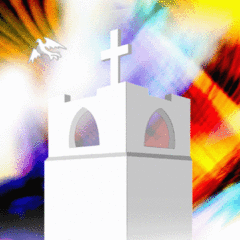When Hilary and I visited England recently for our 30th wedding anniversary vacation, we were blessed to attend a Sunday morning worship service at St. Paul’s Cathedral in London. And interestingly, while we were assembled for worship in that massive sacred space, engulfed by grand Christian architecture all around, the Bible reading from Acts 17 appointed for that Sunday included the following text…
Then Paul stood in front of the Areopagus [in Athens, Greece] and said, “Athenians, I see how extremely religious you are in every way. For as I went through the city and looked carefully at the objects of your worship, I found among them an altar with the inscription, ‘To an unknown god.’ What therefore you worship as unknown, this I proclaim to you. The God who made the world and everything in it, he who is Lord of heaven and earth, does not live in shrines made by human hands, nor is he served by human hands, as though he needed anything, since he himself gives to all mortals life and breath and all things.” – (Acts 17:22-25)
Wow, what an amazingly ironic juxtaposition of worship setting and Holy Scripture!
Now I don’t want to sound like I’m saying that holy places and sacred spaces are unimportant. For indeed, it’s true that great cathedrals, temples, shrines, basilicas, chapels, and even neighborhood church buildings like ours, really do serve a wonderful God-given purpose in the lives of believers. In fact, such structures as these are designed and built by the faithful (according to sacred geometry and symbolism) precisely for the purpose of helping us to set our minds on divine things, as well as to help support us in fellowship and help energize our mission to share the good news of Jesus Christ.
Of course, sometimes we can be lulled into a false sense of stability and security by sacred buildings and structures. And for Jesus’ fellow Israelites at the time of his earthly ministry in the Holy Land, there was very much a false sense of security centered upon one particular building: the Jerusalem Temple.
Whether they lived close to it in Israel or far away from it in Babylon, the Temple in Jerusalem was the sacred magnet that continued to draw the Jewish People back. And the Temple that Jesus visited in Jerusalem was built by King Herod “the Great” in an attempt to gain favor with his subjects, and to have something to brag about to his friend Caesar in Rome. It was the Second Jerusalem Temple, and it stood on the very site of the First Jerusalem Temple built by King Solomon (which had been destroyed centuries before). Herod’s Temple was much more massive and ornate than Solomon’s Temple, and its existence symbolized not only religious revival, but also the continuity of the nation of Israel itself.
Sadly, the Second Temple, which was supposed to be dedicated to holiness and righteousness and charity, was corrupted. So this is why Jesus was upset as he entered (with whip in hand) this enormous symbol of Israel’s identity, driving out those who had turned the Temple into a market of trade merchants. The sacred activity of the Temple had become a profiteering business. As a result, something meant to be prayerful and sacred had been turned into a commercial transaction run by an elite monopoly.
In today’s day and age, we hear about the monopoly of elites over mass media, communication and information, but this was a monopoly of religious elites. Therefore, with great zeal, Jesus put together a whip of cords, and he turned over the tables of the money changers, driving them out with his whip. Of course, I don’t think Jesus actually hurt anyone, but he also wasn’t the meek and mild Jesus of Sunday school imagination either. So in righteous zeal, Jesus fulfilled the Old Testament Prophecy of chapter 14 of Zechariah, that there shall no longer be marketeers (or trade merchants) corrupting the House of the Lord (see Zechariah 14:21).
Consequently, Yeshua (Jesus), a faithful Jew of the First Century, hit at the very heart of First Century Jewish identity and security. He declared that the Temple will be destroyed, and to his listeners that announcement seemed incredible and unthinkable. It struck at their personal and national faith. And even though some Jews believed that God’s Holy Presence had not returned to the Holy Sanctuary of the Second Jerusalem Temple anyway, this didn’t change the fact that Herod’s Temple was still a great symbol of national faith and life.
However, Jesus was simultaneously speaking about both the Jerusalem Temple and the Most Holy Living Temple of his own mortal body, the very Living Temple of God’s New Covenant for the sake of the whole world. So Jesus knew beforehand that he would suffer, die and rise again; that the Temple of his body would be destroyed and renewed for our eternal sake.
And this New Covenant miracle of all miracles grants to us an everlasting identity and an eternal security, built entirely upon God’s grace through faith in Jesus Christ by the power of the Holy Spirit. For as the Apostle Paul states in the Epistle to the Ephesians…
“You are no longer strangers and aliens, but you are citizens with the saints and also members of the Household of God, built upon the foundation of the Apostles and Prophets, with Christ Jesus himself as the Cornerstone. In him the whole structure is joined together and grows into a Holy Temple in the Lord; in whom you also are built together spiritually into a dwelling-place for God.” – (Ephesians 2:19-22)
Together in Christ, Pastor Tim
